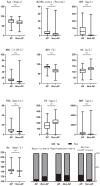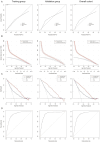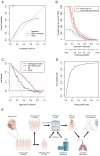Innovative nomogram for predictive risk stratification of aspiration pneumonia in post-stroke dysphagia patients
- PMID: 40529443
- PMCID: PMC12170325
- DOI: 10.3389/fneur.2025.1556541
Innovative nomogram for predictive risk stratification of aspiration pneumonia in post-stroke dysphagia patients
Abstract
Background: Post-stroke dysphagia (PSD) affects up to 76% of stroke patients and increases aspiration pneumonia (AP) risk, leading to higher mortality among older survivors. Current risk assessment tools for AP in PSD patients lack precision.
Methods: We conducted a retrospective study of 7,134 stroke patients admitted to Jinshan Hospital from 2019 to 2023. We used multivariable logistic regression to identify AP predictors and constructed a nomogram model using these predictors. Model performance was evaluated using bootstrap resampling, calibration, and decision curve analysis. Internal validation was conducted on 30% of cases, and external validation was performed on 500 PSD patients from community health centers.
Results: Among 2,663 PSD patients, 578 (21.7%) developed AP. Independent predictors included age, stroke severity, hyperlipidemia, hyperhomocysteinemia, heart failure, CRP, WBC, neutrophil ratio, Hb, FBG, prealbumin, BNP, and serum sodium. The nomogram model showed excellent discrimination (C-index: 0.885) and good agreement between predicted and observed AP probabilities. It provided net benefit across various threshold probabilities.
Conclusion: Our study developed the first dedicated nomogram for AP risk prediction in PSD patients, incorporating novel predictor combinations and demonstrating robust validation across multi-center cohorts. This fills an important clinical need under community conditions by enabling early identification of high-risk PSD patients using routinely available clinical variables.
Keywords: aspiration pneumonia; nomogram model; post-stroke dysphagia; risk prediction; stroke outcomes.
Copyright © 2025 Wang, Wang, Shen, Liao, He and Pan.
Conflict of interest statement
The authors declare that the research was conducted in the absence of any commercial or financial relationships that could be construed as a potential conflict of interest.
Figures






Similar articles
-
Development and validation of a nomogram for predicting intracranial infection after intracranial aneurysm surgery.Front Neurol. 2025 Jun 2;16:1563848. doi: 10.3389/fneur.2025.1563848. eCollection 2025. Front Neurol. 2025. PMID: 40529435 Free PMC article.
-
Differentiation of early-stage tumors from benign lesions manifesting as pure ground-glass nodule: a clinical prediction study based on AI-derived quantitative parameters.Front Oncol. 2025 May 19;15:1573735. doi: 10.3389/fonc.2025.1573735. eCollection 2025. Front Oncol. 2025. PMID: 40458715 Free PMC article.
-
Risk factors and establishment of a nomogram model for pulmonary arterial hypertension complicated by acute exacerbation of chronic obstructive pulmonary disease.Am J Transl Res. 2025 May 15;17(5):3917-3927. doi: 10.62347/XMTE6690. eCollection 2025. Am J Transl Res. 2025. PMID: 40535618 Free PMC article.
-
Prevalence and odds of anxiety and depression in cutaneous malignant melanoma: a proportional meta-analysis and regression.Br J Dermatol. 2024 Jun 20;191(1):24-35. doi: 10.1093/bjd/ljae011. Br J Dermatol. 2024. PMID: 38197404
-
Assessing the comparative effects of interventions in COPD: a tutorial on network meta-analysis for clinicians.Respir Res. 2024 Dec 21;25(1):438. doi: 10.1186/s12931-024-03056-x. Respir Res. 2024. PMID: 39709425 Free PMC article. Review.
References
LinkOut - more resources
Full Text Sources
Research Materials
Miscellaneous

